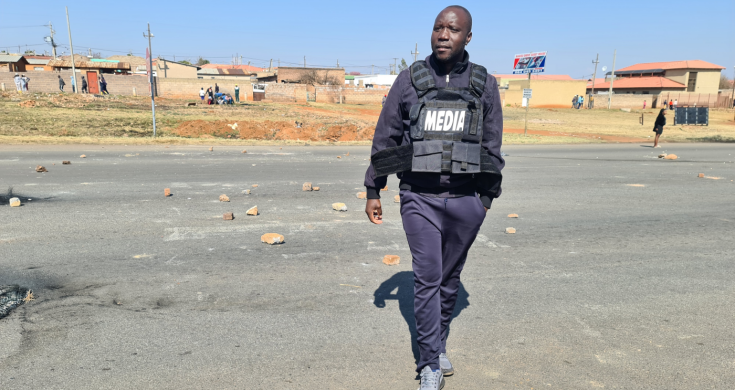More voters than ever in history will head to polls this year. Elections in at least 64 countries in 2024, including the EU parliamentary elections, will represent approximately 49% of world population. Taking place against a backdrop of heightened geopolitical tensions, elections in many parts of the world make it a defining year for media outlets too.
This creates an interesting phenomenon. Elections influence the workings of the media, and the way the media covers the polls will play a role in the outcome of the elections. This circularity gives rise to interesting challenges for independent media around the world. The challenge is to judiciously optimize resources (usually limited in nature for most outlets) to ensure maximum reach and impact. And more importantly, the challenge of competing for the audience’s attention while they are constantly inundated with unvetted, sensationalist and often polarizing mis/disinformation on social media.
According to Jelani Cobb, the dean of Columbia Journalism School, the ability of news to influence voters’ opinions on issues has been altered. Talking about the situation now, Cobb says, “The perspectives people have on what happens in the election will realistically be some combination of information they receive from high-quality, vetted news sources and an array of misinformation and disinformation that has proliferated since the 2016 election.” Newsroom leaders at Project Multatuli, a public journalism platform in Indonesia dedicated to serving the under reported, agree with Cobb’s sentiment. They felt that during the recent elections, “influencers and social media content (often partisan and sensational ones) gained the most attention from the audience instead of trustworthy journalism products”.
Vying for the audience’s attention is one thing, but once you have it, a conundrum independent media often faces is: How do you stand out amid information clutter/overload during the elections?
According to media consultant Fraser Harding, media organizations globally have managed to address this question by providing “meaningful, engaging journalism in formats which cater to reader preferences”. This often comes in the form of “easily digestible audio and short-form video packaged as ‘explanatory journalism’.”
MDIF clients reflect this trend and often experiment by introducing new ways to reach the audiences with accurate information.
Josh Talks, an MDIF client, is one of India’s largest regional content and upskilling platforms. With the unique positionality of being a non-news media platform with millions of viewers, the platform conceptualized Citizens’ Townhall, a combination of inspiring content on social media and offline interactions between first-time voters and Chief Electoral Officers, providing a platform for open dialogue and knowledge-sharing to inspire confidence in the electoral process. This initiative, designed in partnership with Meta, reached approximately 1.3 million people on social media platforms and many first-time voters through offline sessions during the 2023 state elections, popularly seen as a warm-up for the general elections this year. According to Supriya Paul, CEO of Josh Talks, the initiative was aimed to “empower young people on the importance of exercising their vote and to educate them about the power and responsibility that comes with being part of the world’s largest democracy”. Josh Talks also registered an active engagement with election related polls from 70% of their audience community during the recently concluded general elections.
Project Multatuli on the other hand, despite being closer to a traditional journalism model, ran a spate of unique initiatives. This included a three-part satirical comedy show, a series of articles in collaboration with other independent outlets and a two-day festival in Jakarta offering discussions, workshops, music, film screening on issues that reflect the concerns and criticisms of the current political climate in Indonesia.

In February this year, El Faro, an award-winning newspaper and digital outlet in El Salvador, produced journalistic videos on YouTube and TikTok, earning them a peak in audience growth during the months of presidential and legislative elections. June 1 marked the beginning of Nayab Bukele’s unconstitutional second term, a situation which has arisen in El Salvador for the first time since 1935, when Maximiliano Hernández Martínez, the then president, adopted the same tactics as Bukele is doing now. Responding to the severity of these developments, El Faro rolled out a bold move by publishing the first page of their newspaper in sepia tone, just as it used to be published in 1935 during the dictatorship of Hernández Martínez.
Scrolla, a South African news start-up aimed at redefining the mobile-first user experience by posting short news updates on a daily basis, launched a podcast summarizing election manifestos and their political editor, Zukile Majova, posted daily one-minute videos on election topics.

We asked leaders at Josh Talks, Project Multatuli, El Faro and Scrolla to share lessons they learnt this election season that would help independent media outlets in preparing for elections still to happen this year (including Gahana, USA, Taiwan and many others) and beyond.
Here’s a quick squeeze of the lessons they shared:
Empower your audience with accurate information
As polarizing mis/disinformation continues to rise, empower your audiences with verified and accurate information, building relevance and trust by weaving issues of national importance into your narratives in a way that connects with people at an emotional level.
Collaborate with other independent outlets
In times when newsrooms are competing with social media influencers for audience’s attention, other media organizations that share your journalistic values are more friends than competitors for you. Collaborating with other media means getting introduced to each other’s audience, sharing resources and, most importantly, sharing risks.
Fail more, keep trying
What do you do when you report facts and shed light on problematic leaders, their shoddy business ties and electoral frauds and they still get voted to power? This becomes a major blow for journalists and activists and prompts one question: Are we in an echo chamber? Especially when you see audiences engage with fun, bite-sized, unverified content on social media in comparison to your in-depth, long-form journalistic articles. This should prompt you to try new approaches, maybe fail, but keep trying until you find the “right balance between quality content and good engagement”.
Be didactic, but not condescending
Tell stories that matter, but in a way that the audience wants and needs the information to be able to process and use it effectively.
The medium is the message
Once you have decided on what story to tell, spend proportionate time on deciding how you want to tell the story. Will it be a text-only story? Will it be accompanied by infographics? Should it be a video? This requires clarity of thought and, most importantly, optimization of resources in a way that you invest in the way you want to tell the story so that the readers find it easily digestible and see value in sharing it with others.
People matter the most Lastly and most importantly, always remember that people matter the most. Put the public in public-interest journalism at the heart of all your stories.
(Note: This is not an exhaustive list of MDIF clients that have covered elections in 2024.)
